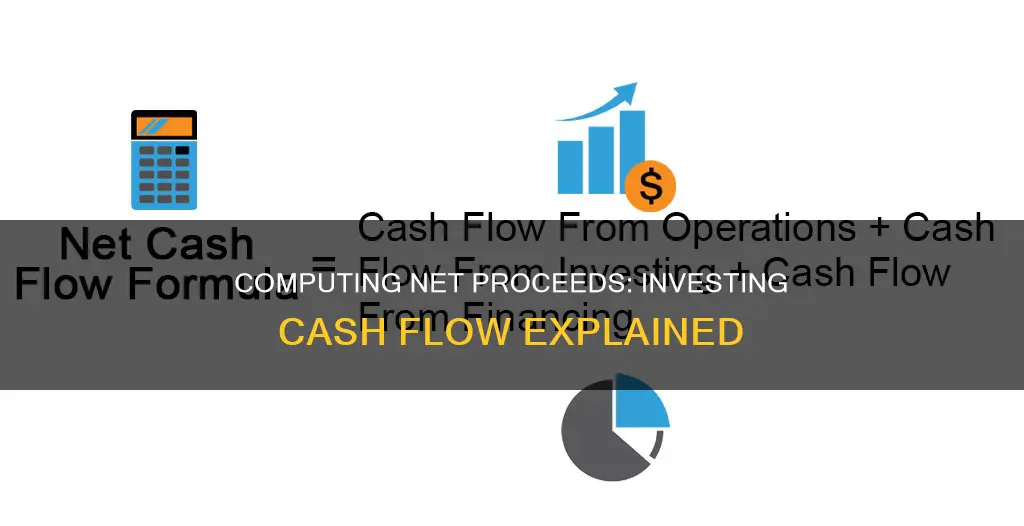
Net cash flow is a profitability metric that represents the amount of money produced or lost by a business during a given period. It is calculated by working out the difference between a business's cash inflows and outflows. Generally, net cash flow is comprised of three categories: operating activities, financial activities, and investing activities.
Operating activities refer to the capital generated and used by a business's basic operations, including expenditures for administrative expenses and receipts from customers. Financial activities refer to the capital generated through debt agreements or cash that has been issued to pay off debts or dividends. Investing activities refer to the capital generated by profitable investments or cash issued to make an investment or purchase fixed assets.
The formula for net cash flow is:
Net Cash Flow = Net Cash Flow from Operating Activities + Net Cash Flow from Financial Activities + Net Cash Flow from Investing Activities
Alternatively, this can be simplified to:
Net Cash Flow = Total Cash Inflows – Total Cash Outflows
| Characteristics | Values |
|---|---|
| Definition | Net cash flow is a metric that tells you whether more cash came in or went out of a business within a specific period of time. |
| Formula | Net cash flow = total cash inflow – total cash outflow |
| Importance | NCF gives a business owner and potential investors insight into the financial health of a business. |
| Limitations | In isolation, NCF does not tell the full story. The reasons behind a negative NFC can sometimes be positive for the business. |
What You'll Learn

Cash Flow from Operating Activities
The formula for calculating CFO is:
CFO = Net Income + Non-Cash Items + Changes in Working Capital
Non-cash items include depreciation, amortization, and other non-cash expenses such as stock-based compensation. Changes in working capital refer to adjustments in accounts receivable, inventory, accounts payable, and other operating assets and liabilities.
The cash flow statement, which includes CFO, is one of the three main financial statements required in standard financial reporting. It provides an account of the cash used in operations, including working capital, financing, and investing activities. The other two sections of the cash flow statement are cash flow from investing activities and cash flow from financing activities.
The direct method for calculating CFO tracks all transactions in a period on a cash basis, using actual cash inflows and outflows on the cash flow statement. This method is favoured by the Financial Accounting Standards Board (FASB) as it offers a clearer picture of cash flows. However, it is less commonly used because it requires a reconciliation report, making it more complex.
The indirect method, used by most companies, begins with net income from the income statement and then adds back non-cash items to arrive at a cash basis figure. This method is simpler as it uses information directly from the income statement and balance sheet.
Overall, a positive cash flow from operating activities indicates that a company's core business activities are thriving, while a negative cash flow may signal issues in the day-to-day running of the business.
Operating vs Investing: Where Do Customers Fit in Cash Flow?
You may want to see also

Cash Flow from Investing Activities
Positive cash flow from investing activities is generated by sales, which produce income. Negative cash flow comes from purchases, which require spending money. However, negative cash flow from investing activities is not always a bad sign. It can indicate that a company is investing in long-term growth and capital, such as research and development, property, or equipment.
Consider a hypothetical company that, over a year, spent $30 billion on capital expenditures, $5 billion on investments, and $1 billion on acquisitions. The company also made $3 billion from the sale of investments. To calculate the net cash flow from investing activities, you would add together all of these amounts, resulting in an annual figure of -$33 billion.
It is important to note that the net cash flow from investing activities is just one component of the overall net cash flow, which also includes operating activities and financing activities.
Cashing Out Your SoFi Investment: A Step-by-Step Guide
You may want to see also

Cash Flow from Financing Activities
The formula for calculating cash flow from financing activities is as follows:
> Cash Flow from Financing = Debt Issuances + Equity Issuances + (Share Buybacks) + (Debt Repayment) + (Dividends)
In this formula, debt and equity issuances are considered positive cash inflows, as the company is raising capital. On the other hand, share buybacks, debt repayment, and dividends are treated as negative cash outflows, represented within parentheses.
It's important to note that cash flow from financing activities is just one component of the overall cash flow statement. The statement also includes cash flow from operating activities and cash flow from investing activities, providing a comprehensive view of the company's financial position.
A positive cash flow from financing activities indicates that more money is flowing into the company, enhancing its assets. Conversely, a negative cash flow from financing activities doesn't always signify poor financial health. It could mean that the company is servicing, retiring debt, or making dividend payments and stock repurchases, which can be viewed positively by investors.
When analysing cash flow from financing activities, it's crucial to consider the context and other financial indicators to make informed decisions and assessments.
Cash Investments: Revenue or Not?
You may want to see also

Calculating Free Cash Flow
Free cash flow (FCF) is a measure of a company's profitability and financial health. It represents the cash that a company generates after accounting for cash outflows to support its operations and maintain its capital assets. It is calculated using the following formula:
FCF = Operating Cash Flow – Capital Expenditure
FCF can also be calculated using the following formula:
FCF = Net Income + Non-Cash Expense – Increase in Working Capital – Capital Expenditure
The first formula is more common as it is simpler and uses two numbers readily found in financial statements: operating cash flow and capital expenditures. The second formula includes non-cash expenses such as depreciation and amortization, and changes in working capital, which is calculated by subtracting current liabilities from current assets.
FCF is an important metric for investors as it helps them analyse the financial health of a company. It shows how efficient a company is at generating cash and can indicate whether a company has enough cash for dividends, paying down debt, and pursuing growth opportunities. A positive FCF indicates that a company is in good financial health, while a negative FCF could be a sign of financial trouble. However, a negative FCF is not always bad, especially if the company is investing in its growth.
Other financial metrics that investors use to analyse a company's financial health include return on investment (ROI), debt-to-equity (D/E) ratio, and earnings per share (EPS).
Journaling a Large Cash Investment: A Step-by-Step Guide
You may want to see also

Limitations of Net Cash Flow
Net cash flow (NCF) is a crucial metric for assessing a company's financial health and performance. However, it has certain limitations that should be considered when interpreting the data:
- Non-cash transactions: NCF only captures cash transactions and excludes non-cash items such as depreciation, amortization, and changes in working capital. These non-cash transactions can significantly impact a company's financial position, so they should be considered alongside NCF.
- Timing of cash flows: NCF statements provide a summary of cash inflows and outflows over a specific period but do not indicate when these cash flows were received or paid. This limitation makes it challenging to assess a company's overall cash flow management and timing of transactions.
- Lack of detail: While NCF statements provide a high-level summary, they lack detailed information about the specific sources and uses of cash. This limitation makes it difficult to identify the underlying factors driving the cash flows and perform a comprehensive analysis.
- Subjectivity in classification: The classification of cash flows can vary between companies due to different accounting policies and interpretations. This inconsistency makes it challenging to compare cash flow statements across different companies or industries, limiting their usefulness as a benchmarking tool.
- Limited predictive value: While NCF statements provide valuable information about past cash flows, they do not necessarily predict future cash flows. Changes in market conditions, business strategies, and economic factors can impact a company's future cash position. Therefore, it is important to consider other factors when making investment decisions.
- Potential manipulation: Like any financial statement, NCF statements can be manipulated to present a more favourable picture of a company's financial performance. Companies may use techniques such as delaying payments or accelerating collections to influence the numbers. Caution and consideration of the company's overall financial health are necessary when interpreting NCF statements.
- Limited comparability: Due to variations in accounting practices, comparing NCF statements across different companies or industries can be challenging. This limits the ability to use NCF statements as a benchmarking tool for evaluating a company's performance relative to its peers.
To overcome these limitations, it is essential to consider NCF in conjunction with other financial statements and factors. By combining NCF with additional metrics and analysing trends over time, investors and analysts can gain a more comprehensive understanding of a company's financial health and make more informed decisions.
Fidelity's Cash Policy: What Investors Need to Know
You may want to see also







